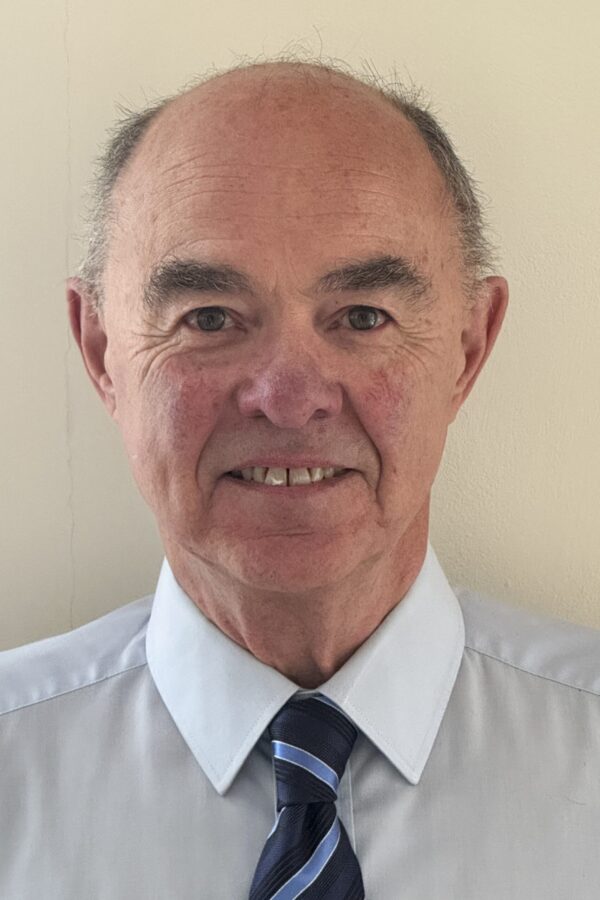
In 1985, British technologist Professor Sir Martin Sweeting set up Surrey Satellite Technology Limited (SSTL) with £100 and four employees. The company pioneers rapid-response, low-cost and highly capable small satellites, on which much of our modern life depends. SSTL is a corporate spin-off from the University of Surrey, where Sweeting is a Distinguished Professor who founded and chairs the Surrey Space Centre.
In recognition of his pioneering work on cost-effective spacecraft engineering, Sweeting was knighted in 2002 and in 2008 he was awarded the Royal Institute of Navigation Gold Medal for the successful GIOVE-A mission for the European Galileo system. In 2016, he was made an Honorary Fellow of the Royal Aeronautical Society and listed by Sunday Times as one of the 500 most influential UK citizens. He holds the Arthur C Clarke Lifetime Achievement Award, the Faraday Medal and and Elektra Lifetime Achievement Award.
In 2025 AIT CEO Tola Sargeant sat down with Sir Martin to talk about his fascinating career.
Sir Martin Sweeting was born in Highgate in the early 1950s. “Life focused very much on school. I was very fortunate, because despite living in London, we actually enjoyed quite a large garden which my father had let run wild, so it was a bit of a jungle. Myself and my younger sister spent a lot of time out in the garden doing the stuff the kids did in those days.” Martin’s mother was an artist and he describes his father as a “literary gentleman” with “absolutely no idea of science whatsoever”. His maternal grandfather had a mechanical background, and his paternal grandfather was a Victorian entrepreneur. He adds: “He was not in engineering or science, but he did lots of little things, he built a wind turbine to power his house before they had electricity and things like this. My immediate family, my mother and father, had no idea about science. So, when I got interested in electronics and things like that, they just let me get on with it.” Martin recalls his interest in engineering, adding: “When I was five or six, I remember really getting interested in my electric train set and how that worked. I started to try to see what else I could do with the set rather than just let the trains run around. So, knowing absolutely nothing about electronics or anything like that, I started trying things out. My parents bought me a transistor radio, and I noticed that if I tuned the transistor radio around and listened on another radio, I got a whistle. I realised, without knowing what was happening, that one of them was communicating to the other. It got me interested in communications.” Martin was also given a toy with two cans attached by strings through which you could talk, this was followed by a wired telephone. He adds: “That whole idea of remote communications fascinated me. Today, we have the internet and everything else so nobody even thinks about this, but in the 1950s the idea that you could talk to somebody at a distance without using the telephone was something that caught my imagination, and that’s really what triggered my whole life.” Martin went on to become a radio amateur. He adds: “I spent three or four years involved in amateur radio and then the Apollo moon landings happened, and that linked the two things together.”
Martin says: “I went to a prep school called Normansal which had no rules. The secret of their success was you had to turn up to lessons but other than that you could do whatever you wanted. We would go and live in a grass hut in the grounds and wander off around the grounds at three in the morning. It was quite an informative period because it somehow taught a degree of self-reliance and independence.” Martin says his strongest subject at school was English. He was also good at Physics and Latin, thanks to having access to good teachers. He explains: “I was not very good at chemistry, because I don’t have a good memory. Physics somehow clicked. Maths was hopeless, because I could never remember the sequences, it just didn’t click. It always took me a long time to work it out from first principles, which was very good but hopeless in an examination environment. It was the same with chemistry, I could answer questions that other kids couldn’t answer because I could do it all from first principles. “I knew I didn’t have that type of retentive memory, so I had to do everything from first principles, deriving it, which gave me a great flexibility to adapt to new situations, but it wasn’t terribly suited to the examination process, and then later on in life, that ability really paid off. “English was my strongest point, and physics and Latin. I was hopeless at French because I had a hopeless French teacher, and I had a really good Latin teacher, and I think it just demonstrated to me the importance of having the right teacher. If you click with a teacher, it makes all the difference in the world. I had a good physics teacher and a hopeless maths teacher, and I’ve lived to regret that the rest of my life. It goes to show that even if you’re not excelling at school in maths and chemistry and things, you can do well… anything.” After prep school, Martin went to a secondary school where he studied Physics, Chemistry and Maths at A level.
Martin came in to contact with his first computer at secondary school around the age of seventeen, having made a connection with City University that had a computer. He explains: “I managed to wheedle my way in to being able to use this computer to compute the distances between two radio stations for some reason. It was very crude by today’s standards, you had to work out your programme and punch it onto cards via a mechanical puncher.”
Following on from his A levels, Martin had accepted a place at the University of Manchester Institute of Science and Technology (UMIST) to study electronics, however, after a chance visit to the University of Surrey, near Guildford, which was being built at the time, Martin decided to switch to Surrey. He says: “I chucked in my place at Manchester and came to this new university, which nobody had ever heard of. It didn’t really exist, but somehow there was something about it that just made me feel this was an interesting environment. The University was built upon Battersea College of Technology in London and a lot of the staff came from there. The other academic staff came from industry around the country. Battersea was also the University of free Poland during the Second World War so there were a lot of very qualified Polish technicians and lecturers.” Martin explains that none of them had any ‘history’. He adds: “They were much more open to crazy ideas, had I gone to Manchester I’m sure I would have been compartmentalised into certain things.”
At university, Martin focused on amateur radio and shortwave communications. They set up a radio club and started to track the early satellites. He explains: “We built up some very crude equipment to track the early American and Soviet spacecraft and try to decode the transmissions and see if we could decode the images that they were sending. Today we see satellite pictures every day on the news and nobody thinks about it, in those days, getting a picture from a satellite yourself was pretty amazing. We built up our homemade equipment to do that, and that’s where this combination of radio communications and space started to take shape.” The club was also invited by American amateur radio groups to help control a satellite which was having difficulty as it passed over Europe. Martin adds: “So we had this set up which allowed us to communicate with that satellite in two directions. We did that for three or four years and it turned out to be rather essential training of how to communicate with a satellite that’s misbehaving.” With this satellite experience and while doing his PhD in radio communications, Martin decided he would like to try to build a small satellite in his spare time using some of the modern micro electronics which had become available with the advent of the first micro-computer. He says: “I probably should have spent more time with my PhD, but luckily my academic supervisors in the university were very tolerant of this and encouraged me. They were supportive. The technical staff would chip in, the academic staff would chip in and help, and so the whole thing grew.” Martin was inspired by the fact that in the mid 1960s a series of amateur radio satellites had been built and launched in the US and Australia. They were built by groups of enthusiasts who mostly worked for NASA. He adds: “They built these things in their spare time and NASA launched them as piggyback payloads for free when they launched a big satellite. I got to know them having helped out for a couple of years with their misbehaving satellite, so when we said we’d quite like to do that in the in the UK, they were very helpful. They provided quite a lot of support and because they worked for NASA, they also introduced me to the launcher people in NASA.” As a result of this collaboration, Martin was offered the opportunity to launch their satellite on a free piggyback load on a NASA rocket. “Parts of this satellite were literally built on the kitchen table. It was the size of a big washing machine and it weighed about 70 kilos. We built a clean room in one of the university laboratories, going down to B&Q and buying wood and polythene and putting it together and using a vacuum cleaner running in reverse to keep the dust out. “I remember that first launch, I wasn’t able to go.” Martin remained in the UK as the point of contact with the satellite for post launch. He continues: “The Americans very kindly set up a telephone link so I could hear the countdown, and then they reported as things went.” Once the satellite was in orbit, Martin says that the big challenge was to locate it and communicate with it. He adds: “The next thing is how do we find the thing, how do we track it? How do we get it to work? By today’s standards it was very, very crude and difficult. String and sealing wax! Everybody thinks building a satellite is the difficult bit, and yes, it is hard, but the really hard thing is operating it successfully in orbit. The satellite flies over for only 10 minutes at a time, so you only see it four or five times a day. Most of the time it is out of range and doing its own thing, or not. In those days, we communicated through this sort of crackly telephone line with lots of errors and so on. You can’t see it, you can’t press the reset button.” Martin continues to explain: “That first satellite worked, much to the surprise of everybody, and it was really good, because we had a huge audience of schools who were tracking it. We had deliberately designed it so that the transmissions on the satellite could be picked up using a very simple VHF receiver, which was affordable, easy to be bought those days, and you could link it into the very first of the home computers called the BBC Micro.” After the success of the first satellite, NASA invited Martin and his small team of mates to put a second satellite on their next rocket which would be ready to launch in six months. Martin says it took years to build the first one, to build the second one in six months required a massive non-stop effort from everyone. He adds: “We had to work literally day and night for six months. We were still building it when we arrived at the launch site. It was physically and psychologically very demanding for the team. The core team were working from about 7.30 in the morning until 3.30 in the morning, and then we would have three and a half hours sleep, and then start again, seven days a week, all the way through for six months. When you look at the photos of people at the end, they look like Zombies, including me. But we did it you know, by the skin of our teeth, and that satellite is still transmitting today.” The second satellite provided a weekly news sheet that schools could download through the telemetry. Martin says: “In the days before the internet, people around the world could pick up the satellite and they would download this news sheet every week. It created a huge interest. We used to get lots of postcards and letters coming in and from people all around the world who picked this up and downloaded it, and then we could put this onto the news sheet and transmit it, and it would be picked up worldwide.” Having inserted a chip out of the popular child’s toy “Speak and Spell” into the satellite, it was able to transmit information in a robotic voice. Martin explains: “When the satellite worked out its temperature and voltages and currents, it would then feed that into that chip, and then it would speak it in this robotic voice. So, kids with the radio, even without BBC, could hear the satellite when it flew over, saying ‘the temperature is 48 degrees centigrade’. It meant that a lot of school kids and radio amateurs would track it, and they used this to write it down.” The team also used the speaking chip to allow a Russian and Canadian team of skiers who were travelling from Russia to Canada via the North Pole, to more accurately understand where they were when their compasses did not work at the North Pole. Martin explains: “The Russians contacted us because they’d heard about our work, and they said the ski party has a little beacon which bleeps all the time. We pick it up in Moscow and can compute where they are, but we can’t tell them. If we send you the coordinates every day, can you put it into your digi-talker, and they can listen. We did that for about six weeks, that was a really interesting experiment, before the internet, GPS and Sat Navs etc.”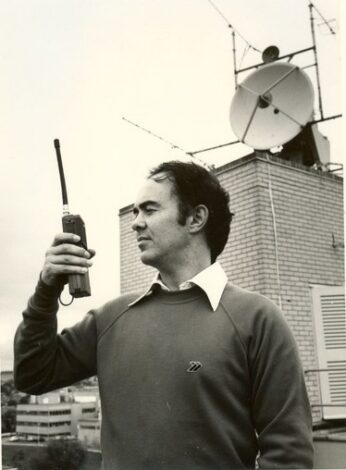
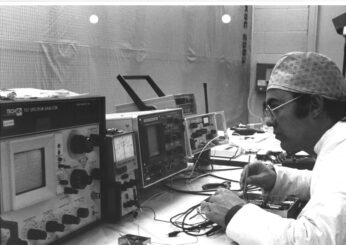
Having successfully built and launched two satellites with the support of the University, sponsorship by British industry and government establishment sites, the team wanted to continue. But they knew they couldn’t do it on the same basis as before, without proper funding, and the UK space programme had just been cancelled. Martin says: “You can only ask British Industry for sponsorship twice. It’s very difficult to go around and do that a third time. In fact, I was told you’ve done that, go and get a proper job. I did have a few interviews, and I decided I wasn’t really sure if a proper job really suited me.” At the same time, Martin received strong interest from the international community. He adds: “The international community told us that what we were doing was quite interesting. As they couldn’t afford to do space like NASA they asked if we could help them take their first steps into space. We knew we would have set up a company and so we formed Surrey Satellite Technology Limited, a spin out of the university.” The company was launched forty years ago with just four people and a small loan from the University which became the major shareholder. It is still running today. Martin explains: “The University introduced a consulting company who took a small shareholding and in return, advised on how to structure the company. They stayed with us for quite a number of years. They didn’t do a lot, but they did give us a little bit of credibility when we were out talking to customers because it wasn’t just the University company, it was a university company with a quite well-known consulting company associated with it.” After ten years, the company, which had grown to over 100 employees, was building satellites for countries around the world including South Korea, Thailand, Portugal and France among others. It was while he was at the National Space Symposium in Colorado Springs that Martin was asked to meet Elon Musk regarding his idea of a project on Mars. While the project work did not progress, Musk returned to talk to Martin a second time with the proposal of building his own rocket. At the same time, the University was concerned with the size and liability of the projects the company was taking on and wanted to transfer ownership of the company. Musk joined Surrey Satellite Technology as an investor in 2006 and sat on the board until 2009 when he started SpaceX. Martin explains: “Musk was a shareholder with a 10 or 15% percent stake. He helped guide us through the transition. We had to find a new owner. It took nearly nine years trying different potential mixes. We went out to the market and we had offers but none of them really felt right. To the university’s great credit, they stuck with it until we found the right one. Eventually Airbus gave the best guarantees of looking after us. They weren’t the highest bidder quite, but the university and the government, at the time, said this is the best mix. Airbus wanted to buy 100%, so Elon then sold his share with a profit and he went on to do other things.”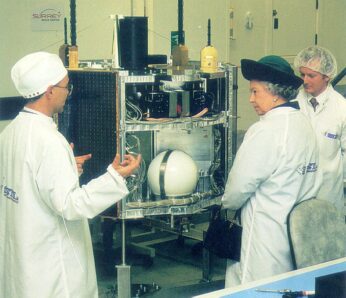
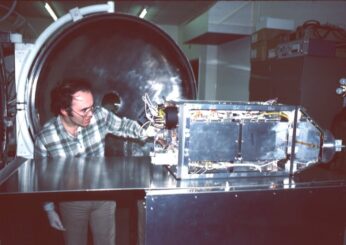
Surrey Satellite Technology sat within the University of Surrey campus and as such worked very closely with the University’s research team which went on to establish the Surrey Space Centre. The close collaboration brought benefits to all concerned as Martin explains: “When we formed the company it lived inside the academic research team. We were cohabiting in the same building and there was an interplay between the academic research and the commercial exploitation, which is very difficult to do if you just set out with two different groups and say, right, get together and collaborate. But because it grew up this way, we found that that synergy was extremely effective. It allowed us to have new ideas from the research team and then exploit them, and then the results of that exploitation fed back into the research. It also allowed us to do training programmes.” One of the major projects born out of the collaboration is training developing space nations to develop their own safe Space capability. Martin continues: “We brought in teams of a dozen engineers from South Korea, first, then Thailand, Algeria, Nigeria, Portugal, and Malaysia. They lived with us for a year or two, learned how to do something, then went back. A company would find that very difficult to do, but having that academic environment allowed us to do that.” Asked about the longevity and success of Surrey Satellite Technology, as a founder who is still involved after forty years, Martin says: “If there is one magic ingredient, it is co-location. I’ve always argued very strongly for co-location. Since moving we’ve never managed to recapture that and so now we have to work quite deliberately at it. Fortunately, we have that genetic material in our relationship, so we can build on it, but it’s much harder. It takes a lot more effort and isn’t as effective as it was when we were cohabiting.” Many of the company’s employers have been there long term, asked why this might be, Martin says: “It’s an exciting area. It’s pretty taxing, we don’t drive people hard to make money, we want to do something different. We try to do things that other people aren’t doing, and therefore it’s difficult, and therefore you tend to work pretty hard.” Prior to COVID, Martin met with every single new employee and spent time talking with them, introducing them to the company and getting to know them as individuals. He adds: “COVID interrupted this, and now even several years after COVID, it’s really difficult to reform those links with the people who have joined since then. So, we’re trying to find out other ways to do it. But up until COVID, that was an important ingredient, because they had a personal link to the company, and to me and others in the company, and that connection is really important.” Martin also took steps to reduce the company size around ten years ago from 600 down to a more manageable 300-400 employees, he says: “I felt at 600 people, there were people in the company I didn’t know or recognise, and I didn’t like that. I also felt that the company was getting into a different mode of operation, and so we deliberately allowed the company to shrink back and the optimum was probably in the 300 to 350, 400 range because at that size you can have a relationship with individuals in the company to a greater or lesser extent. We recognise them, they know you, and the communication within the group is reasonably effective, and it doesn’t become too impersonal.”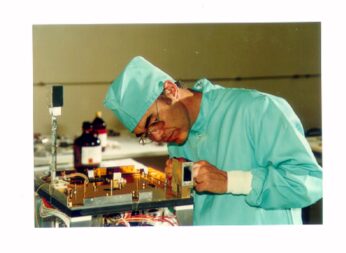
Asked what advice he would give a young person today thinking about a career in technology, Martin says: “Whatever you do, if you have the choice, choose something which you’re interested in, something that stimulates you.” “Should you go into space? Space is already playing a huge part of our daily lives, and it’s going to play even more. I’ve just finished a study for the Royal Society looking at space in 2075 and space is going to have a huge impact on everybody’s life, whether you’re in space or not. Space is a good thing to get into, but do something that you’re interested in.” “Space is not just building bits of satellites. It’s everything from finance to safety to policy to legal to ethics to medicine, all of that is in space. So, you can be a biologist in space, you can be a lawyer in space. It’s not necessarily just the technology.”
Asked about the importance of space and satellites in our lives today, Martin says: “Most people don’t realise how dependent we are on space. All of our utilities, electricity, gas and communications, are coordinated and timed from space, if you use your sat nav while driving, that’s coming from space, combined with 5G etc. We rely on space for weather, communications, the internet. If space stopped, our life would come to a grinding halt almost immediately. We would be in serious trouble within a few days. It’s absolutely embedded in our everyday life, and it’s only getting more so.” Speaking about the expansion in the number of new satellites in orbit and the impact of companies such as Musk’s SpaceX and Starlink, Martin says: “First of all, it’s providing another layer of communication. So we’ve had geostationary satellites, landlines and fibre and so forth, and we’ve got this network in the middle and now the communications that we use is a mix of all of those. “Musk is up to 8000 or 9000 satellites now and that’s a huge number of satellites. If you just look at the number over the years, it’s increased hugely in just the last three or four years. One of the side effects of that is congestion. Space is big, but the number of satellites is still relatively small compared to the number of bits of debris. There’s about a million pieces of debris, and there’s probably around 15,000 satellites in total, including all the previous ones. So, the chances of debris interacting and hitting on these satellites is much increased.” Martin explains that debris can compromise of old satellites, bits of old rockets, spanners dropped by astronauts, even flecks of paint or a bolt or nut, all of which can cause a great deal of damage when travelling at 20,000 kilometres an hour. He adds: “What we’ve seen is that whereas 10 years ago, we would get warnings of a potential collision once every few months, now we’re seeing it once an hour or so, and we have to decide, do we manoeuvre out the way, do we leave it etc. “In addition, the environmental aspect of this is quite important, and we need to make sure that when our satellites get the end of their life, they’re disposed of in an appropriate manner. It is a key issue, but it’s one, fortunately, that people are waking up to, but policy and regulation hasn’t caught up with it yet. He adds: “The problem is, like a lot of environmental stuff, who pays for the cleanup? And at the moment, that’s not clear, because it’s expensive. You can’t clean all of it up, it’s just not practicable. So it’s a question of how do you remove bits of debris which pose the biggest risk, and who pays?” Martin and his team experimented using satellites to clear up debris using either a net for smaller pieces, based on the concept of the Roman net, or a spear for larger pieces. The idea has been picked up by a Japanese company called Astroscale, who are in the process of developing a commercial business. Martin adds: “We launched a satellite, we put a video camera on it to watch so you can go on the internet now and see this at ‘removeDEBRIS’. You can watch the video of the satellite actually demonstrating these two things.”
Asked what excites him the most about the possibilities of technology today, Martin says: “It’s the applications – and AI covers a wide range of things, so it’s machine learning, AI approaches and so forth. It’s this type of advanced computing process. How do we manage space traffic control more effectively? How do we utilise the space environment in terms of making better use of the imagery and so forth from satellites? How do we now move manufacturing into orbit. The International Space Station has shown us we can make new materials, new pharmaceuticals, but they’re in tiny quantities. Can we now start to do this at scale by in-orbit manufacturing?” Looking at the longer-term future and the report which Martin has written with the Royal Society on space in 2075, he says: “We’re not trying to predict the future because we’ll get it wrong. Neither are we saying we should do this or shouldn’t do that. What we’re saying is look at where we are today, and look at the direction of travel of our technologies and what we’re doing, and if you project those ahead as best we can, these are the sorts of things that might come out of it. “For example, in-orbit manufacturing, space tourism around the moon, a human base on the moon, rather like we have on the Antarctic, possibly commercial activity on the moon for exploitation of materials, putting up scientific instruments on the moon, later on Mars. A lot of this will be done robotically initially, but then, if you have people working on the moon for extended periods of time, there’s all manner of ethical, sociological and legal issues that you need to look at. So, it’s not just the technology. We have to be thinking about the ethics. “If we do go to Mars, which won’t be in the near future, but as we get towards 2075 maybe we will be able to have a human outpost on Mars, what happens if you have children born on Mars? They will have physiological implications. What are the ethics of that? You won’t be able to stop it. But how do we deal with it. If you have a human workforce on the moon, how do you organise that and safety, and all of these things? So we were trying to say, if these things unfold as we suspect they might, can we start thinking about them now, so we’ll be better prepared for when they happen? “Thinking back to the ’80s, when the internet was beginning to be formed, if we thought about the implications for society, hopefully we might have made a slightly better job of being prepared to deal with it. So, the purpose of the report is basically to try to get people to stop and think about what space might mean for them as it evolves, and hopefully, naively, hope that they/we might be slightly better prepared. Just like digitalization has transformed society, this will have a similar effect. So let’s not sleepwalk into it.”